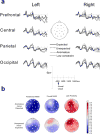Event-related brain potentials reveal age-related changes in parafoveal-foveal integration during sentence processing
- PMID: 28987909
- PMCID: PMC5720378
- DOI: 10.1016/j.neuropsychologia.2017.10.002
Event-related brain potentials reveal age-related changes in parafoveal-foveal integration during sentence processing
Abstract
Normative aging is associated with deficits in visual acuity and cognitive control that impact the allocation of visual attention, but little is known about how those changes affect information extraction and integration during visual language comprehension in older adulthood. In the current study, we used a visual hemi-field flanker RSVP paradigm with event-related brain potentials to study how older readers process fine-grained aspects of semantic expectancy in parafoveal and foveal vision. Stimuli consisted of high constraint sentences with expected, unexpected but plausible, or anomalous parafoveal target words, as well as low constraint sentences with neutral but expected target words. Older adults showed graded parafoveal N400 effects that were strikingly similar to younger readers, indicating intact parafoveal semantic processing. However, whereas young adults were able to use this parafoveal pre-processing to facilitate subsequent foveal viewing, resulting in a reduced foveal N400 effect, older adults were not able to. Instead, older adults re-processed the semantics of words in foveal vision, resulting in a larger foveal N400 effect relative to the young. Collectively, our findings suggest that although parafoveal semantic processing per se is preserved in aging, there exists an age-related deficit in the ability to rapidly integrate parafoveal and foveal visual semantic representations.
Keywords: Aging; ERP; Parafoveal processing; Sentence processing.
Copyright © 2017 Elsevier Ltd. All rights reserved.
Figures




References
-
- Altarriba J, Kambe G, Pollatsek A, Rayner K. Semantic codes are not used in integrating information across eye fixations in reading: Evidence from fluent Spanish-English bilinguals. Perception & Psychophysics. 2001;63:875–890. - PubMed
-
- Baccino T, Manunta Y. Eye-fixation-related potentials: Insight into parafoveal processing. Journal of Psychophysiology. 2005;19:204–215.
-
- Ball KK, Beard BL, Roenker DL, Miller RL, Griggs DS. Age and visual search: Expanding the useful field of view. JOSA A. 1988;5:2210–2219. - PubMed
-
- Balota DA, Yap MJ, Hutchison KA, Cortese MJ, Kessler B, Loftis B, Treiman R. The English lexicon project. Behavior Research Methods. 2007;39:445–459. - PubMed
-
- Barber HA, Ben-Zvi S, Bentin S, Kutas M. Parafoveal perception during sentence reading? An ERP paradigm using rapid serial visual presentation (RSVP) with flankers. Psychophysiology. 2011;48:523–531. http://dx.doi.org/10.1111/j.1469–8986.2010.01082.x. - DOI - PMC - PubMed
MeSH terms
Grants and funding
LinkOut - more resources
Full Text Sources
Other Literature Sources
Medical

